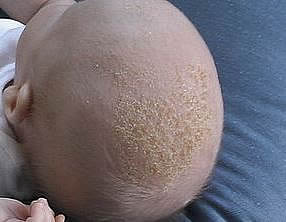Many babies develop cradle cap on their scalps when they are about two to three months old and – despite the fact it is quite unsightly – there is no need for parents to be concerned.
The condition will usually clear up by the time a baby is around six months old and it does not relate to how well a child is being cared for
What is cradle cap?
Cradle cap is a build up of harmless greasy and flaky skin patches on a baby’s scalp.
Our bodies are constantly producing new skin cells at roughly the same rate as we lose our old and dry skin cells.

In many healthy babies and infants, new skin cells on their scalps are being produced at a faster rate than the old skin cells fall off – and this results in the development of an extra layer of old and dry skin, known as cradle cap.
Cradle cap is a form of seborrehic dermatitis, a skin condition that is common among newborns and young babies. It is a scaly and crusty rash which is caused by the drying of excess oils which are excreted from the child’s body. It can look quite similar to dandruff.
When does cradle cap develop?
Cradle cap usually appears in the first two to three months. It can occur in any baby and is not the result of poor hygiene. It has normally cleared up by the time a child is six or seven months old.
Parents sometimes become anxious about cradle cap because it is quite unsightly and unsettling to look at – but it is a completely harmless and a non-contagious condition.
Some studies have revealed that cradle cap can develop in babies who have a member of their family who has asthma or eczema.
What is the cause of cradle cap?
The sebaceous glands in the skin of babies are hyper-activated and this causes them to secrete an oily substance called sebum.
These glands become hyper-activated due to the extra hormones produced by the mother which are passed to her little one just before birth. When a baby’s hormones level levels out, the condition will usually go away, often without any need for treatment.
Normally old skin will dry and fall off our bodies, but the sebum on a baby’s skin keeps the old skin cells attached as it dries, creating a scaly, dry skin which is similar in appearance to dandruff.
Cradle cap is often mild in babies but in more severe cases, it may result in a thick, oily, yellowish, and waxy scaly patches on the child’s scalp. Small areas of a baby’s hair may sometimes become detached along with the scales, but the hair will grow back again, so there is no cause for concern.
Which areas of the body does cradle cap affect?
Cradle cap mainly affects the scalp but is also sometimes found on the neck, face, armpits, behind the ears and knees, head, eyebrows, and on a baby’s bottom.
Do you need to treat cradle cap?
As long as it doesn’t bother a baby, cradle cap doesn’t need to be treated. In most babies the condition clears up long before they are a year old. It is rarely very troublesome to a baby and it only becomes itchy in extreme cases.
Until a baby outgrows the condition, there are various things parents can do you to minimise the possibility of cradle cap causing any discomfort.
Washing the child’s hair once a day with a mild baby shampoo can help to remove the scales. Some parents use a special cradle cap brush to remove them. A toothbrush with very soft bristles is another option.
If the scales prove stubborn and difficult to loosen up, it’s worth applying a small quantity of petroleum jelly to the baby’s scalp.
Dentinox Cradle Cap Treatment Shampoo for Babies is a very popular product in the UK which gently softens the scaly areas of the scalp.
To remove the build up of scales and soften them, parents can consider rubbing a small amount of baby oil, coconut oil, vegetable oil or olive oil on to the affected areas. After waiting for several minutes, a soft brushing should help to remove the scales.
Here are a few of the best-selling cradle cap products at Amazon.
Era Organics Healing Ointment for Babies - USDA Certified Organic Natural Gentle Moisturizer for Sensitive Skin Prone To Baby Eczema, Cradle Cap (Infant Seborrheic Dermatitis), Rashes, Hives & More
£23.53Dentinox Cradle Cap Treatment Shampoo for Babies, 125 milliliters
REPAVAR Pediatrics Shampoo for Cradle Cap - (Crust Milk) Prevents irritations. Shampoo for Newborns 200 mililiters
DermaFrida The SkinSoother Baby Bath Silicone Brush by Fridababy | Baby Essential for Dry Skin, Cradle Cap and Eczema (2 Pack)
£16.99Baby Hair Brush with Wooden Handle and Super Soft Goat Bristles (Burlywood)
£7.99Kokoso Baby Happy Scalp Cream - Safe, Natural, Effective Scalp Treatment for Delicate Baby Scalps - For Dry, Oily and Sensitive Scalps (50ml)
(as of February 3, 2024 - More infoProduct prices and availability are accurate as of the date/time indicated and are subject to change. Any price and availability information displayed on [relevant Amazon Site(s), as applicable] at the time of purchase will apply to the purchase of this product.)Pourty Cradle Cap Massage Brush Blue
£6.50Baby Brush And Comb Set Infant Massage Hair Brush and Comb Gift Set For Cradle Cap
Parents should avoid any temptation to scratch or pick the scaly areas as this could lead to infection.
Cradle cap will normally clear up after a few months but, if the condition persists, parents should seek medical advice. Medicated shampoo, cradle cap cream or anti-fungal treatment is sometimes prescribed by doctors.




































